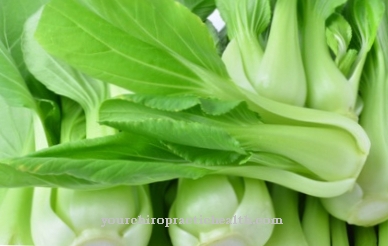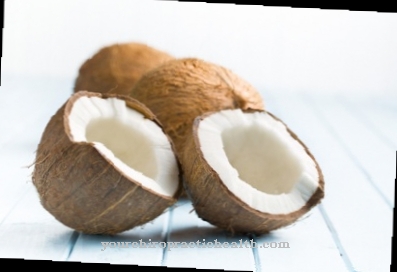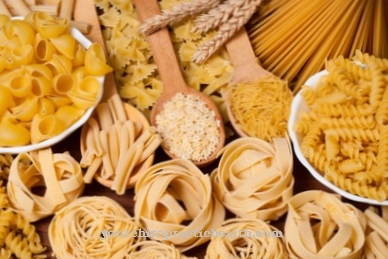Of the Tuberous calf's peppers belongs to the umbellifer family. Visually it resembles the meadow chervil. Its beet-like root is a little-known gourmet vegetable. It is also known as chervil. Other names are: Chervil, Bulbous chervil, Beet chervil or Beet calf's crop such as Earth chestnut.
What you should know about the bulbous calf's goiter

Calf heads are a genus of plants in the umbelliferae family. The bulbous calf's goiter (Chaerophyllum bulbosum) has a so-called hypocotyl tuber - just like beetroot or radish. This tuber lies under the thickened stem base and has added the name "tuberous" to the plant.
This tuber forms the tasty part of the plant. When raw, it tastes spicy and hot. After cooking, the taste is completely changed. The aroma is sweet and is reminiscent of the sweet chestnut, which is why it is also called earth chestnut. If the tuber has been exposed to frost, it will taste like hazelnut after cooking. The aboveground leaf and flower part of the plant reaches a stately height of 80 - 200 cm. The tender shoot tips can also be used in the kitchen. The tubers are rather small. With their spherical or conical shape, they reach a length of 1.5-10 cm and a diameter between 3 and 6 cm. Their weight is 140-200 g per root.
The outer bark is gray-brown and can also be eaten. There are two subspecies: The Siberian chervil has adapted to the habitat in Russia. It survives steppe fires unscathed because its roots can survive in the ground for up to 10 years and then sprout again. The domestic chervil is two years old. Your tuber serves as a nutrient reserve that is used up during flowering. The bulbous calf's head with its two subspecies is originally found in Central and Eastern Europe, Scandinavia, the Balkans, Russia and Western Siberia. It was introduced by monks in Austria and Germany during the Middle Ages.
All wild chervil are remnants of earlier vegetable cultivation. The plant did not reach France until the 19th century. There it is now considered a delicatessen vegetable. In general, this type of vegetable has largely been forgotten and is hardly or not at all cultivated. The cultivation is similar to that of carrots and parsnips. After the autumn harvest, the seeds are sown in the fields in September / October. The cultivation period is 9-10 months.
The tuber is harvested in July. Since the tuber only develops its real aroma when the leaves are removed, it is stored for several months. The optimal storage temperature is 4 ° C. Brief treatment at freezing temperature is also possible in order to provoke the hazelnut aroma of the root vegetables. The rare vegetable tuber goes on sale between November and March.
Importance to health
The chervil is very nutritious because of its high percentage of starch and protein. In contrast to most vegetables, the tuberous veal crop is genetically still in its very original state.
Only in France in 1986 two cultivars were bred. There are no genetic breeding adaptations to fertilizers or pesticides. Anyone who values foods that are as natural as possible has a unique vegetable on their plate in the chervil. It is ideal as part of a slow food diet.
Ingredients & nutritional values
The tuber consists mostly of protein and starch. The domestic chervil has a significantly higher starch content than its Siberian relatives.If the tuber is frozen, its sugar content increases. The root vegetables are above all a healthy source of energy. It is very low in fat.
Intolerances & allergies
There are no known intolerances. However, the root vegetables are almost completely forgotten and are only rarely consumed. Therefore there are no studies on this. In general, diabetics in particular should be careful with the consumption and check for themselves whether the sugar and starch content is easily digestible for them.
Shopping & kitchen tips
The chervil cannot be bought in the supermarket. It can be found at weekly markets where farmers sell themselves. However, it is very rare. Since the wild plants differ in their yield from cultivated plants, after sowing in a field they do not grow as regularly and closely lined up as classic cultivated vegetables.
The shape and size of the roots are also different for every beetroot. The cultivation of this old vegetable is therefore only of interest to small or organic farms that have a close relationship with customers through direct marketing. Alternatively, the sales market via online ordering services is interesting. Use is made of this especially in the organic sector. Larger farms that sell their crops to middlemen cannot sell these vegetables. Since several months of storage before the sale is complex, all of these conditions are reflected in the price.
As a rarity with hard to calculate income and very limited sales opportunities, the kilo price is unusually high. If you have a tight budget, you can sow the plant in your own garden. It feels comfortable in a moist, partially shaded and sandy location. It should only be fertilized moderately. Under no circumstances should wild plants be harvested from nature. For laypeople it is easy to confuse the umbellifer with other plants it resembles.
This includes not only harmless plants such as the wild carrot and the meadow chervil, but also highly poisonous species such as the spotted hemlock. If you do not want to use up the tubers you have bought or grown yourself, you can beat them like carrots into moist sand and store them for a longer period of time.
Preparation tips
As a delicate vegetable in the kitchen, the tuberous veal cap is unbeatably diverse. It can be used as a potato substitute with a fantastic aroma or as a vegetable side dish for hot dishes. Soups, ragouts and raw vegetables are also possible. The tubers can be braised, roasted or baked in the oven just like new potatoes. The bowl should also be used.
Like the potatoes, the tubers have to be cooked with fat. Whether crackling, butter or oil is a matter of taste. In this way, the chervil bulbs - best seasoned with salt, parsley or chervil - are a great alternative to the potato side dish on meat. Your chestnut taste with a slight note of marzipan comes into its own here. This also applies to a delicate preparation as a beet side dish. Here the tuber can be prepared like Teltower turnips. They are caramelized in a butter-sugar mixture in the frying pan.
Then everything is extinguished with vegetable or meat broth (depending on the dish) and bound with flour. Creamy soups are also elegant. This is where the tubers are cooked. The root meat can then be squeezed out of the rind and prepared as a creamy starter with salt and herbs. The tuber can be grated as raw food. Due to its hot flavor, it can be combined with milder beet varieties - carrot, parsnip or beetroot.



























